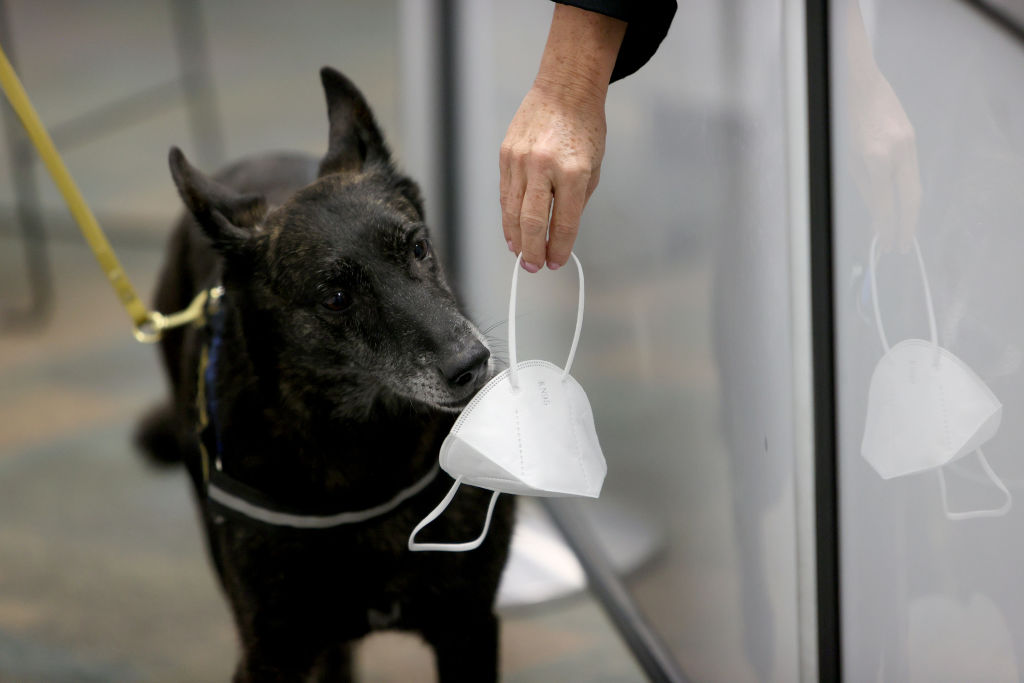
A dog’s sense of smell is thousands of times stronger than a human’s. Their superior snoots are why canines are used in law enforcement; once they’re trained to detect certain scents, like narcotics and explosives, they can pick up traces that human noses could never notice. The same skill translates to medicine. Research shows that dogs can sniff out evidence of cancer and other diseases with impressive accuracy—and a recent study adds more evidence to suggest the same is true of SARS-CoV-2, the virus that causes COVID-19.
In the study, which was published in the journal PLOS ONE and builds on a smaller one published in 2020, dogs from French fire departments and the UAE’s Ministry of the Interior were trained to recognize the smell of compounds associated with SARS-CoV-2 in human sweat samples. “The welfare of the dogs was fully respected, with toy rewards and a total absence of work-induced physical or mental fatigue,” the authors write.
The researchers then collected sweat from the armpits of almost 350 people seeking COVID-19 testing at sites in Paris. About a third of the people tested positive via PCR tests.
The dogs’ overall sensitivity (their ability to pick up on positive samples) was 97%, while their overall specificity (their ability to determine that a sample was negative) was 91%. That puts dogs’ diagnostic capabilities in the same league as gold-standard PCR tests, says study co-author Dominique Grandjean, a professor at France’s Alfort School of Veterinary Medicine.
Almost any dog can be trained to do this type of detection in a matter of weeks, Grandjean says. “We could have hundreds or thousands of dogs doing this for almost [no money], and they would be as efficient as PCR,” Grandjean says.
Dogs could potentially be deployed in crowded areas, like airports or conferences, or in other places where traditional testing is not widely available, to sniff out positive cases. They could also be used to test people who don’t respond well to invasive nasal swabs, such as those with autism or neurodegenerative diseases, Grandjean says.
There’s already some proof of concept. Finland’s Helsinki-Vantaa International Airport experimented with COVID-sniffing dogs in 2020, and a study published in May found their accuracy was around 98%, though there weren’t enough positive cases to draw firm conclusions about sensitivity. Miami International Airport also tested COVID-sniffing dogs last year, as did multiple schools in Massachusetts.
Dogs can also detect viral compounds in sweat from Long COVID patients up to 18 months after they first caught the virus, according to a study co-authored by Grandjean and posted in January on MedRxiv, a server for new research that hasn’t yet been peer-reviewed. (The study was subsequently published in the Journal of Clinical Trials.) Canines in that study detected evidence of the virus in samples from 23 out of 45 Long COVID patients in the trial, but not among any of the sweat samples that came from 188 people without Long COVID. That accuracy rate may be an underestimate, says co-author Emilie Seyrat (who has Long COVID), because some samples had to be sent through the mail during the summer and thus may have been compromised by heat and time.
Still, the results are intriguing. Scientists don’t fully understand why some people develop chronic symptoms after a case of COVID-19, but one of the main hypotheses is that remnants of the virus linger in some people’s systems and potentially continue to replicate, causing lasting health problems.
The fact that dogs can smell virus-related compounds more than a year after people initially got sick supports that idea, says Dominique Salmon-Ceron, an infectious disease specialist at Hôtel-Dieu Hospital in Paris and another author on the Long COVID study. “Our results add to the argument that the virus can probably persist” in the body, she says.
The study wasn’t designed to diagnose anyone with Long COVID, since participants were already known to have the condition. And detecting viral persistence isn’t the same as diagnosing someone with a complex, multi-system disease like Long COVID, Salmon-Ceron says.
But dogs can add to scientists’ understanding of the condition and validate patient experiences. Many Long COVID patients struggle to get proper care because they can’t prove they had COVID-19, particularly if they got sick early in the pandemic, before testing was widely available.
“Nobody was believing them, except some doctors,” Salmon-Ceron says—and, now, some dogs.
More Must-Reads From TIME
- The 100 Most Influential People of 2024
- The Revolution of Yulia Navalnaya
- 6 Compliments That Land Every Time
- What's the Deal With the Bitcoin Halving?
- If You're Dating Right Now , You're Brave: Column
- The AI That Could Heal a Divided Internet
- Fallout Is a Brilliant Model for the Future of Video Game Adaptations
- Want Weekly Recs on What to Watch, Read, and More? Sign Up for Worth Your Time
Write to Jamie Ducharme at jamie.ducharme@time.com